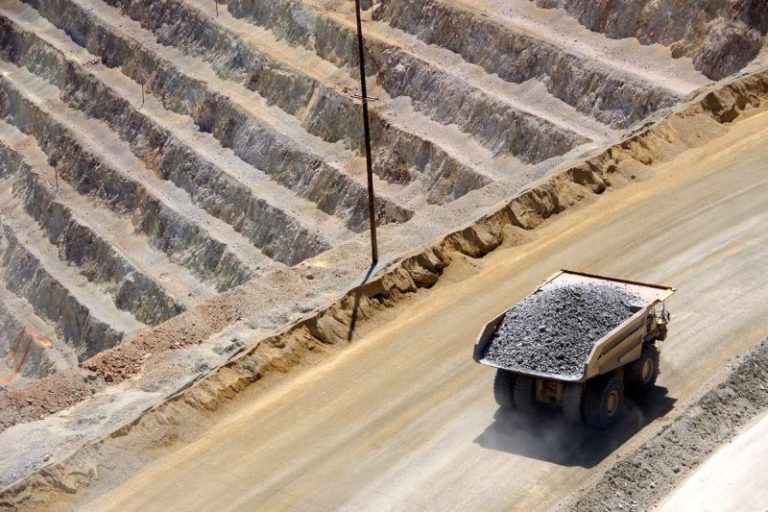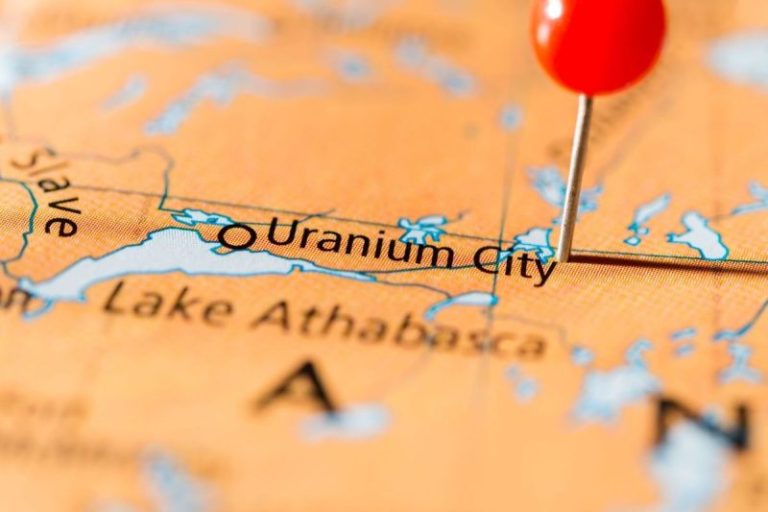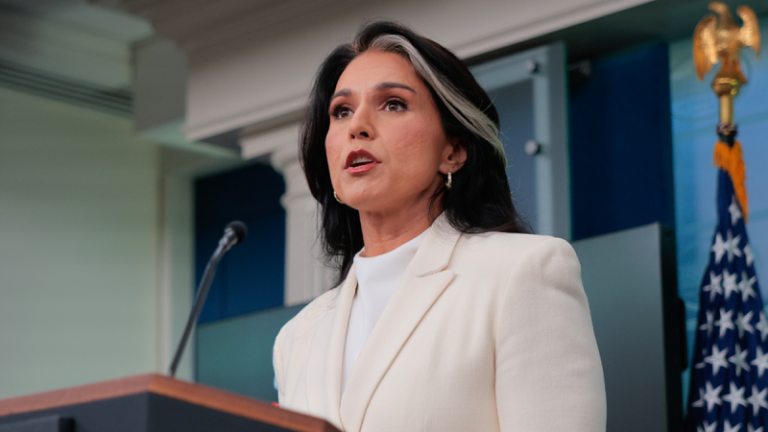Uranium mining in Canada accounts for 13 percent of global output, making the Great White North the second largest producer of uranium in the world, behind only Kazakhstan.
Canada hosts 9 percent of the world’s uranium resources and is home to the biggest deposits of high-grade uranium. Their grades of up to 20 percent uranium are 100 times greater than the global average.
Canadian uranium deposits are found mainly in the provinces of Saskatchewan, Newfoundland and Labrador, and Québec, as well as the territory of Nunavut. Of these, Saskatchewan leads the country in both uranium exploration and production.
Top Canadian uranium mines
Canada is home to three producing uranium mines, Cigar Lake, McArthur River and McClean Lake, all of which are located in Saskatchewan’s Athabasca Basin.
Saskatchewan is a premier uranium mining jurisdiction as home to the Athabasca Basin, a mining-friendly region in the north of the province that’s renowned for its high-quality uranium deposits. The area’s long uranium-mining history has made Canada an international leader in the uranium sector.
Canada’s major uranium mining companies are Cameco (TSX:CCO,NYSE:CCJ) and Orano Canada, a subsidiary of the multinational company Orano Group. Cameco is the majority owner and operator of Cigar Lake and McArthur River. Orano holds a significant stake in both mines, and is also the majority owner and operator of the recently restarted McClean Lake operation.
Data and information on the Canadian uranium mines and advanced projects discussed below is taken from mining database MDO. The database only includes projects that have at least partial ownership by public companies.
1. Cigar Lake Mine
Ownership:
54.547% — Cameco
40.453% — Orano Canada
5% — TEPCO Resources
Province: Saskatchewan
Mine type: Underground
Deposit type: Unconformity-related
Cigar Lake, which entered commercial production in 2015, is one of Canada’s largest uranium mines and the world’s highest grade uranium mine. The underground mining operation involves the use of innovative mining methods such as jet boring, which was purposely designed by Cameco to tackle the unique challenges of the Cigar Lake deposit.
For 2024, production at the Cigar Lake mine was reported at 16.9 million pounds U3O8, up 2 million pounds from the previous year. Guidance for 2025 stands at approximately 18 million pounds.
Cigar Lake’s proven and probable reserves stand at 551,400 metric tons of ore grading 15.87 percent U3O8 for 192.9 million pounds of contained U3O8. Its mine life is expected to run until 2036.
2. McArthur River-Key Lake Mine
Ownership:
McArthur River mine
69.805% — Cameco
30.195% — Orano Canada
Key Lake mill
83.3% — Cameco
16.7% — Orano Canada
Province: Saskatchewan
Mine type: Underground
Deposit type: Unconformity-related
The McArthur River-Key Lake operation is home to the McArthur River mine and Key Lake mill, respectively the largest high-grade uranium mine and largest uranium mill in the world, according to MDO.
McArthur River was first brought into production in 2000 using raiseboring and blast hole stoping mining methods, but was put on care and maintenance temporarily in early 2018 due to low uranium prices. Cameco brought the mine and mill back into production in late 2022, progressively ramping up output over the next few years.
Production in 2024 came in at 20.3 million pounds U3O8, up nearly 43 percent from the previous year’s output, and production guidance for 2025 has been set at 18 million pounds.
McArthur River’s proven and probable reserves total 2.49 million metric tons grading 6.55 percent U3O8 for 359.6 million pounds of contained metal. Its mine life extends out to 2044.
3. McClean Lake Mine and Mill
Ownership:
77.5% — Orano Canada
22.5% — Denison Mines (TSX:DML)
Province: Saskatchewan
Mine type: Surface mine
Deposit type: Unconformity-related
The McClean Lake mine re-entered production in July 2025, 17 years after it was shuttered in 2008 due to low uranium prices made the operations uneconomic.
After studies demonstrated that the joint venture partners’ patented surface access borehole resource extraction (SABRE) mining method could bring McClean back to life economically, the decision was made in January 2024 to bring the asset back into production.
The site hosts multiple deposits, including the now-producing McClean North deposit. It also boasts the only mill in the world designed to process high-grade uranium ore without dilution, according to MDO. The mill has the capacity to produce 24 million pounds of uranium concentrate, or yellowcake, annually. Currently, the mill is processing ore from the Cigar Lake mine under a toll mining agreement.
Proven reserves at McClean Lake are in the form of ore stockpiles, and total 90,000 metric tons at a grade of 0.37 percent for U3O8 for 700,000 pounds of contained metal. The site also hosts significant indicated and inferred resources of 25.4 million pounds across the McLean North, Sue D and Sue F deposits.
The partners expect to produce approximately 800,000 pounds of U3O8 from McClean North in the first year of operations. In addition, mining at the McClean North and Sue F deposits has the potential to produce about 3 million pounds from 2026 to 2030.
Upcoming Canadian uranium mines
There are a handful of contenders for Canada’s next uranium mine: Patterson Lake South, Rook 1 and Wheeler River. None are in the construction stage yet, but most are expecting to come online in the next few years. Learn about the advanced uranium projects below.
1. Patterson Lake South
Ownership: Paladin Energy (TSX:PDN,ASX:PDN)
Province: Saskatchewan
Mine type: Underground
Deposit type: Basement hosted vein-type or fracture-filled
Currently in the permitting phase, the Patterson Lake South (PLS) project hosts the large, high-grade and near-surface Triple R deposit, which has the potential to produce both uranium and gold. The project has a probable mineral reserve estimate of 93.7 million pounds of contained uranium from 3 million metric tons grading 1.41 percent U3O8.
The 2023 feasibility study for PLS highlights average production of approximately 9 million pounds U3O8 per year over a 10 year mine life.
Paladin added the PLS uranium project to its portfolio in December 2024 via its acquisition of Fission Uranium. The company is continuing to develop the PLS’s resource potential outside of the Triple R deposit, with a significant focus on the project’s Saloon East zone. Advancing through the environmental permitting process remains ongoing.
2. Rook 1
Ownership: NexGen Energy (TSX:NXE)
Province: Saskatchewan
Mine type: Underground
Deposit type: Basement-hosted, vein-type
NexGen Energy’s Rook 1 project, home to the Arrow deposit, is in the permitting stage with a feasibility study completed in February 2021. Arrow hosts probable mineral reserves of 239.6 million pounds of U3O8 from 4.57 million metric tons of ore at a grade of 2.37 percent, as well as a measured and indicated resource of 256.7 million pounds from 3.75 million metric tons at 3.1 percent.
Over its 11.7 year mine life, Rook 1 is expected to produce an average of 19.8 million pounds of U3O8 per year, including over 25 million pounds during the first five years.
Provincial environmental assessment approval was granted in November 2023, and the federal environmental impact statement was accepted as final in January 2025. In March 2025, the company shared that the Canadian Nuclear Safety Commission has proposed hearing dates for the Rook I project on November 19, 2025, and February 9 to 13, 2026.
NexGen states that a full project execution team is at the ready and the site is fully prepared for construction activities to commence following final federal approval.
3. Wheeler River
Ownership:
95% — Denison Mines
5% — Uranium Energy (TSX:UEC,NYSEAMERICAN:UEC)
Province: Saskatchewan
Mine type:
Phoenix — In-situ recovery
Gryphon — Underground
Deposit type: Unconformity-related
The Wheeler River uranium project, billed as the largest undeveloped uranium project in the eastern region of the Athabasca Basin, is home to the high-grade Phoenix and Gryphon deposits. Each deposit is considered a standalone asset, and the Phoenix deposit is the more advanced of the two.
A feasibility study for the Phoenix deposit as an in-situ recovery operation was completed in mid-2023. In February 2025, Denison reported that the Canadian Nuclear Safety Commission is set to conduct hearings for the project’s environmental assessment and license to prepare and construct a uranium mine and mill on October 8 and December 8 to 12, 2025. If granted approval, Denison is prepared to start construction in early 2026, followed by first production by the first half of 2028.
As for the Gryphon deposit, an update to the pre-feasibility study for a conventional underground mining operation was completed in 2023. Denison conducted a field program in the first quarter of 2025 as part of its efforts to support a feasibility study.
Canadian uranium exploration companies
Canada is also home to a slew of uranium exploration and development companies focused on discovering uranium in Saskatchewan, Nunavut and Newfoundland and Labrador.
For more insight on the uranium companies operating in the Athabasca Basin discussed in this article, check out our breakdown of the 15 uranium companies exploring the basin.
Securities Disclosure: I, Melissa Pistilli, hold no direct investment interest in any company mentioned in this article.
This post appeared first on investingnews.com










